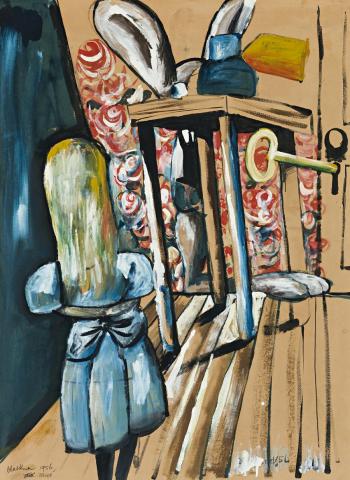ALICE, 1956
Charles Blackman
oil on cardboard
98.0 x 72.0 cm
signed, dated and inscribed lower left: Blackman 1956 / Alice, signed and dated indistinctly lower right: Blackman 1956
Savill Galleries, Sydney (label attached verso)
Private collection, Sydney
Deutscher~Menzies, Melbourne, 2 September 2003, lot 61
Private collection, Victoria
On long term loan to Bendigo Art Gallery, Victoria, 2004 – 2010
Lewis Carroll's tales of Alice's Adventures in Wonderland and Through the Looking-Glass appeal as much to adults as they do to children. Perhaps the appeal to adults is even greater, for they take us back to the wonderland of youth when anything was possible in the everyday blending of reality and imagination. This is one of the reasons why Charles Blackman's paintings are invariably popular, for Blackman so complements Carroll that they almost seem as one. Blackman's colours are as rich as Carroll's words and his images are as inventive as the author's concepts. In translating Carroll into paint, Blackman conjures up lasting moments of that dreamtime for all to enjoy. Unlike John Tenniel, who drew those unforgettable illustrations for the first pages of Alice's adventures, Blackman does not always present a literal moment, providing rather its mood and sensibilities. To this is added Blackman's rare gift of being able to present ideas and images as if seen through the eyes of children. His introduction to Alice was through his first wife Barbara's talking books.
'I knew nothing about Alice [Blackman said] and I'd never seen Tenniel's illustrations. The pictures invoked in me by Alice's story are highly personal. They are all about her [Barbara], but they are also about entering the surreal world with the whole concept of surrealism which I've always loved as a painter.'1
The inspiration for the painting on offer, Alice, 1956, is close to the beginning of the tale - 'Alice falling down the rabbit hole and into the hall with a little door that led 'into the loveliest garden you ever saw.'2 Blackman's painting kaleidoscopes the narration, showing the door, the white rabbit, who misled Alice on her adventures, and the table on which is the bottle labeled 'drink me'. Alice obligingly drunk and shrunk to a size suitable to walk through the door into the garden, suggested by the whirl of flowers to the left background. Blackman introduced haptic proportion to heighten the childlike perception - that is, the more important the person or object, the larger the size. The large key has now taken on an important role, for without it Alice could not open the door into wonderland. The size of the white rabbit's ears, huge foot and one big querulous eye provide further examples. Alice of the long blonde hair and light blue dress is, Barbara Blackman, viewed from the back enabling the viewer's better participation in the unfolding events. The mischievous rabbit, as in other paintings in the series, represents the artist, the creative instinct reaching into the unknown - as will the key enable Alice to do the same. The child's 'surreal' view is extended through the disorganized space, as in a dream, perspective askew, the imbalance extended through the angularity of the floorboards as metaphors of the uphill climb. It is all a little threatening. Anxiety is combined with adventure in the child's dream of mixed emotions. The pictorialisation of this irrationality is achieved superbly. It is one of the reasons why Blackman's Alice series of paintings is among his best works.
1. The artist, quoted in Shapcott, T., The Art of Charles Blackman, Andre Deutsch, London, 1989, p. 23
2. Carroll, L., Alice's Adventures in Wonderland, The Folio Society, London, 1961, pp. 6-7
DAVID THOMAS
